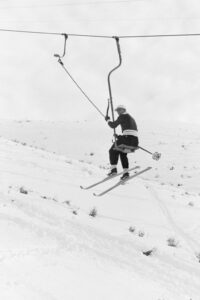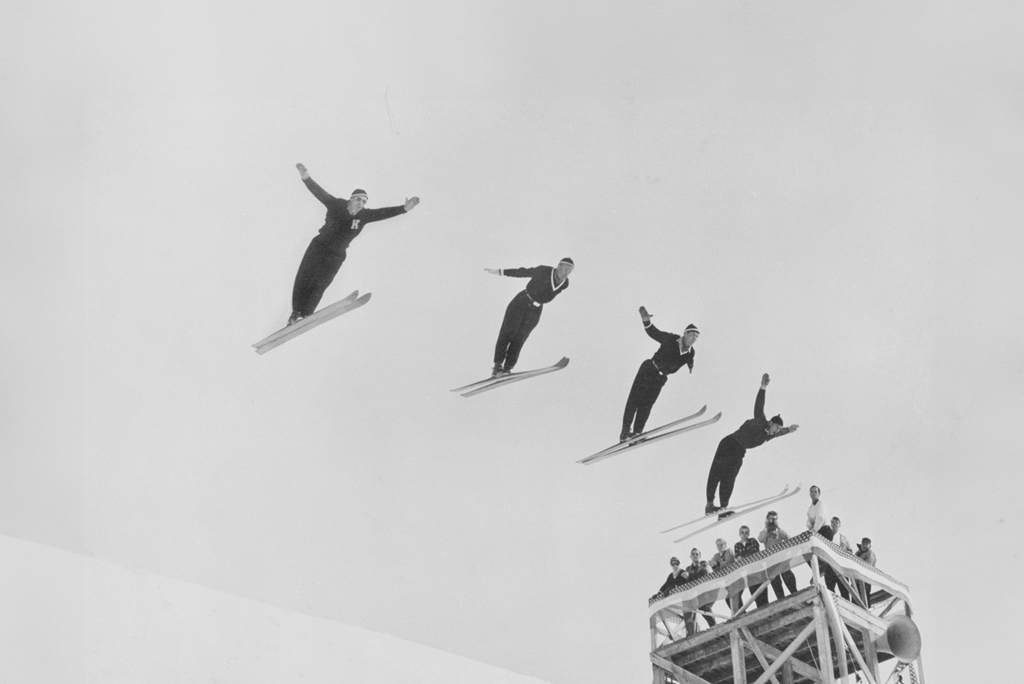Ski jumping at Sun Valley is a forgotten part of its history, but the sport played an important part in making the resort the country’s skiing center. A 40-meter ski jump was built on Ruud Mountain in the summer of 1937, creating Sun Valley’s center for jumping and slalom racing—the site of showdowns between the world’s best ski jumpers and slalom racers.
Called the “St. Moritz of America,” Sun Valley opened in December 1936, built by Union Pacific Railroad to stimulate passenger service decimated by the Great Depression, the pet project of Board Chairman Averell Harriman. The country’s first destination ski resort, it had an ultra-modern lodge offering big city amenities, a ski school with Austrian instructors, and chairlifts invented by U.P. engineers. Ski racer Dick Durrance said it was “the most important influence in the development of American skiing. Its concentrated and highly successful glamorization of the sport made people want to ski in the first place.”

Ruud Mountain, 1938, with a rudimentary single chairlift to take skiers up the hill, a rare luxury in those days. Jumpers got off the lift half way up, to reach the jump located in the middle of the hill. Jumpers were scored for both form and distance by judges in the tower. Skiers went to the top of the hill on the lift. Photos courtesy The Community Library. (This Page, Bottom Left): Famous Norwegian ski jumpers Alf Engen and Sigmund Ruud, who located and designed the jump on Ruud Mountain for Averell Harriman. Photo courtesy the Engen family.
Harriman used ski racing to make his new resort the country’s skiing center. The annual Harriman Cup tournaments were the country’s most prestigious and competitive events, attracting the world’s best skiers. “Just as it is the dream of every tennis player to compete once at Wimbledon, it is every skier’s hope to participate in the famous Harriman Cup races at Sun Valley,” said the 1943 American Ski Annual.
After the first Harriman Cup tournament in 1937, Harriman realized that one thing was missing—a ski jump. Alpine skiing was a fledgling sport, and for several decades, Norwegian immigrants had made jumping the most popular form of the sport. The best skiers at the time were four-way athletes, competing in downhill, slalom, cross-country and jumping.
Harriman asked two famous Norwegian ski jumpers to find a location for a ski jump—Sigmund Ruud (1928 Olympic Silver Medalist, 1937 National Jumping Champion) and Alf Engen (Professional Ski Jumping Champion 1931 – 1935, holder of five world professional distance records). They selected a site between Dollar and Proctor mountains, later named for Sigmund, with an elevation of 6,600 feet and a 600-foot vertical drop. They designed a 40-meter site for jumps up to 131 feet, using the hill’s natural slope, with a profile shaped to “exact international specifications.” Major jumping tournaments required a 70- to 90-meter jump, perfect for four-way competitions.
A rudimentary chairlift was installed on Ruud Mountain, using “a small piece of wood about 16 inches long and six or eight inches wide” to sit on, according to Warren Miller, and lacking a place for riders’ skis. At a time when skiers had to climb hills before coming down, the lift was a welcome change, enabling them to get in far more training runs than ever before. It delighted jumpers “who had been climbing for their skiing all season or jumping off rickety scaffolds on artificial snow.” The best jumpers in the world competed on Ruud Mountain before World War II.
Jumping on Ruud Mountain dropped off after WWII as interest in the sport waned. U.S. Olympic teams trained on Ruud Mountain for the 1948 and 1952 Games, and jumping exhibitions continued, featuring top Norwegian exchange students, but not as part of the Harriman Cup. Ruud’s last jumping event was the 1956 American Legion Junior Three-Way Championships. Slalom races were held there through 1961, often with side-by-side courses for men and women. The 1961 Harriman Cup slalom race was the last, won by Billy Kidd.
In 1965, Ski Party was filmed at Sun Valley, a light-weight musical comedy knock-off of beach party movies. It starred Frankie Avalon and Dwayne Hickman, with an appearance by Annette Funicello and musical appearances by Leslie Gore and James Brown. The movie has scenes filmed on Ruud Mountain, including conventional ski jumps, Frankie Avalon jumping in an inflated clown suit, soaring off like a helium balloon, and a toboggan flying off the jump. This was the last formal use of the ski jump.
From Alf Engen and Sigmund Ruud to Frankie Avalon and Annette Funicello —the saga of the Ruud Mountain ski jump.


